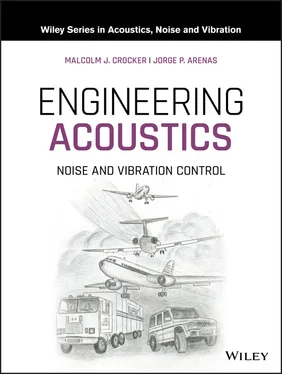1 ...7 8 9 11 12 13 ...53 Real‐time analysis in the frequency domain has many applications, including noise and vibration studies where the signal is nonstationary with time. Such applications include machinery vibration analysis, bearing noise, transient analysis, acoustic emission, speech analysis, music, and others. The goal of this chapter is to define the main types of signals used in noise, shock, and vibration control and also to serve as an introduction to signal analysis. The discussion in this chapter is kept mainly descriptive and those readers requiring a further mathematical discussion of signal analysis are referred to more detailed treatments available in several books [1–9].
1.2 Types of Noise and Vibration Signals
Depending on their time histories, noise and vibration signals can basically be divided into stationary and nonstationary . Examples of the various types of signals in the time and frequency domains are shown in Figure 1.1[10].

Figure 1.1 Examples of different types of signals and their spectral content [10].
Stationary signals can be divided into deterministic and random signals. Stationary deterministic signals can be described by a mathematical function. They are made of a combination of sinusoidal signals (pure tones) with different amplitudes and frequencies. The spectrum of a stationary deterministic signal is characterized by content (power) at discrete frequencies (a line spectrum). The measured displacement signal of a simple mass‐spring system and the noise and vibration signals from machinery rotating at constant speeds are both examples of stationary deterministic signals.
Stationary random signals cannot be described by explicit mathematical functions but instead they must be described by their statistical properties (mean value, variance, standard deviation, crest factor, kurtosis, amplitude probability, etc.). In contrast to stationary deterministic signals, they have a continuous distribution of spectral content. If the random signal has constant statistical values which do not change with time, we refer to the random signal as stationary. The sound produced by rain or a waterfall, the noise produced by turbulent air coming out of a ventilation system, the noise produced by a passing vehicle, and the airborne noise of a circular saw during idle are examples of random signals. A random signal which has a flat (constant) spectral content over a wide frequency range is called white noise .
1.2.2 Nonstationary Signals
Nonstationary signals are divided into transient and continuous signals. Transient signals are signals which start and end at zero level and last a finite and relatively short amount of time. They are characterized by a certain amount of “energy” they contain in the same way that continuous signals are characterized by a “power” value. Examples of transient signals are the sound of a car door closing, a shock wave generated by an impact, the noise produced by a sheet metal stamping press, and the noise of an electric spark.
Nonstationary continuous signals are signals consisting of one or more of the following: sinusoidal components with variable amplitudes and/or frequencies, random signals with statistical properties which change with time, and transients which appear with varying intervals and with varying characteristics in time and frequency. Examples of nonstationary continuous signals are the acceleration on the chassis or frame of a truck driving on a rough road, the wind speed for wind‐induced vibrations, the vibrations or chatter induced in machine tools during machining, the vibration produced by a jackhammer, and speech.
In noise and vibration control, signal analysis means determining from a measurement or a set of measurements certain descriptive characteristics of the environment that will help in identifying the sources of the noise and vibration. Frequency analysis is probably the most widely used method for studying noise and vibration problems. The frequency content of a noise or vibration signal is usually related to a specific component of a given system, such as a machine, so that frequency analysis is often the key to obtain a better understanding of the causes or sources of the noise and vibration.
Sometimes in acoustics and vibration we encounter signals which are pure tones (or very nearly so), e.g. the 120 Hz hum from an electric motor. In the case of a pure tone, the time history of the signal is simple harmonic and could be represented by the waveform x ( t ) = A sin (2 πf 1 t ) in Figure 1.2a. The pure tone can be represented in the frequency domain by a spike of height A at frequency f 1, Hz (see Figure 1.2a).

Figure 1.2 Time and frequency domain representations of (a) pure tone; (b) complex tone; and (c) nonperiodic deterministic signal.
More often, sound signals are encountered which are periodic, but not simple harmonic. These are known as complex tones. Such sound signals are produced by most musical instruments (both wind and string). They can also be produced mechanically or electronically (a square wave is an example of a periodic signal or complex tone). The broken line plotted in Figure 1.2b is an example of a complex tone which is made up by the superposition (addition) of two simple harmonic signals, x ( t ) = A sin (2 πf 1 t ) + B sin (2 πf 3 t ). Note in this case we have chosen f 3= 3 f 1. The signal A sin (2 πf 1 t ) is known as the fundamental (or first harmonic) and B sin (2 πf 3 t ) is the third harmonic. In this particular case the second harmonic and the fourth and higher harmonics are completely absent from the complex tone x ( t ). The frequency domain representation of the complex tone is also given in Figure 1.2b.
In fact, Fourier [11] showed in 1822 that any periodic signal may be analyzed as a combination of sinusoids:
(1.1) 
or in complex notation:
(1.2) 
where ω = 2 πf ; f is the fundamental frequency; T = 1/ f = 2 π / ω , is the period of the signal; j =  , and A nand B nare the Fourier coefficients calculated from [4, 6, 8]
, and A nand B nare the Fourier coefficients calculated from [4, 6, 8]
(1.3a) 
(1.3b) 
Читать дальше





 , and A nand B nare the Fourier coefficients calculated from [4, 6, 8]
, and A nand B nare the Fourier coefficients calculated from [4, 6, 8]












